I learned how to put up both my 8-person tent and the 12×12 foot screen house on a New Mexico “beach”, really the shoreline of a huge Rio Grande reservoir. As I stared at both towering structures with pride, it occurred to me that maybe they were overkill. Then, I remembered, I will be essentially living in the tent and screen house all summer. Then, I remembered the reasoning behind such a huge tent.
To understand, think decades of camping in rain storms. High wind, rain beating on the tent walls and seeping in through the floor. Fleeing to the car, shivering. Wondering why I love to camp. I had had my fair share of stormy, wet nights. One thing I noticed over the years: the center of the tent usually stayed dry. In a small tent, that meant a one-foot spot where I could huddle. In a 4-person dome tent, that meant enough room in the middle for a camping chair where I could sit out the storm.
Alaska is a rainy place; the coastal areas along the Inside Passage are actually rainforests, according to my research. I might get lucky and hit a drier year. I might hit a normal year, which in Juneau, for example, means 67 inches of rain and another 88 inches of snow per year. I might find myself in an extremely rainy summer, according to those who know. In contrast, Deming, NM receives around 10” of rain per year. I need to be prepared to sit out those storms in style, and my little pup tent brings back soggy memories. I decided that a nice big tent with a robust floor, a huge rain fly, and screened-in porch is the solution. If water seeps in, I want a large chunk of space in the center where I can stay dry while I entertain myself with audio books. Yes, the huge tent takes longer to set up but it is really not much different than a little tent scaled up. Two tent poles through the sleeves on top. Another tent pole for the screened porch. Tent stakes, guy wires. My arms are just long enough – not an inch too long or too short — to reach the center top and give it a snap into place. Voila. Nailed it the first time!
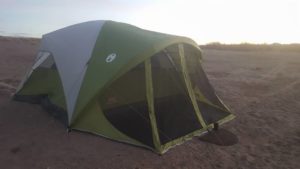 Awesome Coleman tent with a porch and large rain fly. Lots of space to shelter from the rain.
Awesome Coleman tent with a porch and large rain fly. Lots of space to shelter from the rain.
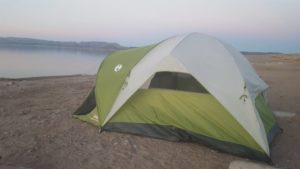
The canopy pole lifts the rain fly up and out from the side windows, making an awning for the windows. Clever!
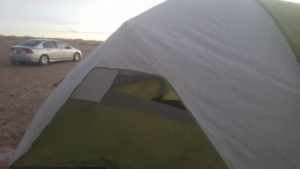
Close-up: window awning.
The screen house? I will be in bear country. A considerate friend of mine who lived in Kodiak, AK for 13 years informed me that I should be okay, since in July when I arrive in Kodiak to see the famous bears, they will be stuffed full of salmon and not likely interested in Tango’s dog food. Seriously, that brought me some comfort. Which would you choose, given the choice? Anyway, I will still need to follow bear-smart camping practices throughout the trip, which includes cooking upwind from the sleeping area. Enter in that rain again plus a gaggle of mosquitos. I need a dryish and bug-free space for cooking. The screen house.
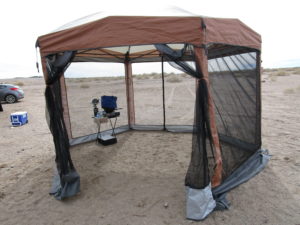
My lovely screen/shade house. A second set of doors opposite the first make it a “drive-through”, a carport for Alice, the Honda Civic! Just kidding.
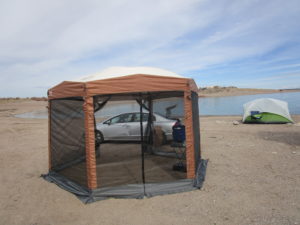
Alice (with the food and dog food) and the screen house/cooking area properly placed upwind from tent. Don’t think I will have such open space and easy options in Alaska!
After setting up the screen house, which is actually easier than the tent in some ways, I realized it may not be totally bug proof. I saw lots of little pathways to the inside, mostly along the ground, under the screening. One thing I learned in my pop-up camper: critters can and do ease their way in through the smallest space. The screen house gives me a fighting chance against the bugs, however. And shade! Besides, I love sitting in there. I can reach over, heat some water in my new camping tea kettle and enjoy a cup of something hot. I have a ridiculous sense of safety and solitude inside the screen house. It’s my space, although I doubt that a bear would grant me the same sense of privacy. It will be upwind from the tent, though. I hope! What if the wind shifts?
So, while an 8-person tent with and a huge screen house, which could double as a carport for my tiny Honda Civic, may seem a bit much for one woman and her trusty little dog, there is a method to my madness. I could sleep in a pup tent and cook in the rain, but this is an extended trip and I want some level of comfort, including a nifty camp cooking area. I leave NM around April 1 and do not arrive on Kodiak Island until July 11. Then, I have to get home, which is around 4,000 miles. I could be gone 6 months although I won’t decide for sure on the second half of the trip – my route home or the timing – until I am sitting on Kodiak Island enjoying tea in my screen house. Preferably not in the rain and on a day when the Kodiak Grizzlies are full of salmon.
Note on tent and screen house: I am a lifelong fan of green Coleman tents. Yes, some have leaked, but when I apply seam seal and don’t subject them to absurd conditions they do well. At the moment, I have the robust 8-person version and a pup tent for quick trips. When I bought my RV, I never expected to tent camp again, but I miss it too much. Go figure. The RV can only get me so far into the wild world.



I think that you’ve absolutely nailed it with your arrangements and why not be comfortable. There was a British commander in WW2 who slept in pyjamas in a camp bed every night, shaved in hit water every morning and had a cup of hot tea before he did anything else, when asked why he replied “any fool can be uncomfortable”; I have tried to make this my rule too.
Please can you explain why you have cooking equipment/food/dog food upwind of you? Won’t this bring their scent towards you? Bears are not a problem in England, at least not since the Middle Ages!
Have a wonderful trip and take care when you do set off; I hope you find occasional WiFi to keep us all updated.
Should I have said downwind? Definately want the cooking area where it wont blow idors back to the tent. Possible I got my up and down wind mixed up! Better find out!!!!